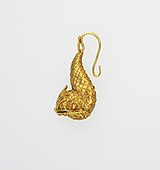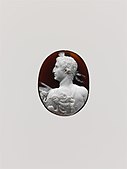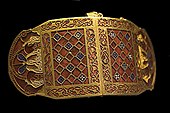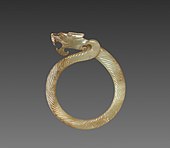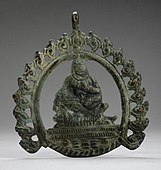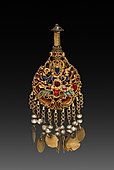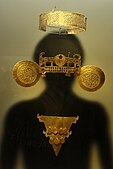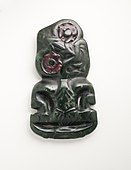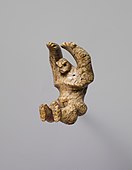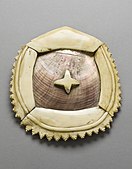Jewellery
Jewellery(orjewelryinAmerican English) consists of decorative items worn for personaladornmentsuch asbrooches,rings,necklaces,earrings,pendants,bracelets,andcufflinks.Jewellery may be attached to the body or the clothes. From a western perspective, the term is restricted to durableornaments,excluding flowers for example. For many centuries metal such as gold often combined withgemstones,has been the normal material for jewellery, but other materials such as glass, shells and other plant materials may be used.
Jewellery is one of the oldest types ofarchaeological artefact– with 100,000-year-old beads made fromNassariusshells thought to be the oldest known jewellery.[1]The basic forms of jewellery vary between cultures but are often extremely long-lived; in European cultures the most common forms of jewellery listed above have persisted since ancient times, while other forms such as adornments for the nose or ankle, important in other cultures, are much less common.
Jewellery may be made from a wide range of materials.Gemstonesand similar materials such asamberandcoral,precious metals,beads,andshellshave been widely used, andenamelhas often been important. In most cultures jewellery can be understood as a status symbol, for its material properties, its patterns, or for meaningful symbols. Jewellery has been made to adorn nearly every body part, fromhairpinstotoe rings,and evengenital jewellery.In modern European culture the amount worn by adult males is relatively low compared with other cultures and other periods in European culture.
Etymology
[edit]The wordjewelleryitself is derived from the wordjewel,which wasanglicisedfrom theOld French"jouel",[2]and beyond that, to theLatinword "jocale",meaning plaything. InBritish English,Indian English,New Zealand English,Hiberno-English,Australian English,andSouth African Englishit is spelledjewellery.At the same time, the spelling isjewelryinAmerican English.[3]Both are used inCanadian English.Howeverjewelryprevails by a two-to-one margin. In French and a few other European languages the equivalent term,joaillerie,may also cover decorated metalwork in precious metal such asobjets d'artand church items, not just objects worn on the person.
Form and function
[edit]
Humans have used jewellery for a number of different reasons:
- functional, generally to fix clothing or hair in place.
- as a marker ofsocial statusand personal status, as with awedding ring
- as a signifier of some form of affiliation, whether ethnic, religious or social
- to provide talismanic protection (in the form ofamulets)[4]
- as an artistic display
- as a carrier or symbol of personal meaning – such as love, mourning, a personal milestone or even luck
- generally considered as a good investment
- superstition[5]
Most[quantify]cultures at some point have had a practice of keeping large amounts of wealth stored in the form of jewellery. Numerous cultures store weddingdowriesin the form of jewellery or make jewellery as a means to store or display coins. Alternatively, jewellery has been used as a currency or trade good to buy and sell.[6]an example being the use ofslave beads.[7]
Many items of jewellery, such asbroochesandbuckles,originated as purely functional items, but evolved into decorative items as their functional requirement diminished.[8]
Jewellery can symbolise group membership (as in the case, of theChristiancrucifixor theJewishStar of David) or status (as in the case ofchains of office,or the Western practice ofmarriedpeople wearing wedding rings).
Wearing ofamuletsanddevotional medalsto provide protection or to ward off evil is common in some cultures. These may take the form of symbols (such as theankh), stones, plants, animals, body parts (such as theKhamsa), orglyphs(such as stylised versions of theThrone VerseinIslamic art).[9]
Materials and methods
[edit]
In creating jewellery,gemstones,coins,or other precious items are often used, and they are typically set intoprecious metals.Platinumalloysrange from 900 (90% pure) to 950 (95% pure). The silver used in jewellery is usuallysterling silver,or 92.5% fine silver. Incostume jewellery,stainless steelfindings are sometimes used.
Other commonly used materials includeglass,such as fused-glass orenamel;wood,often carved or turned;shellsand other natural animal substances such asboneandivory;naturalclay;polymer clay;Hemp and other twines have been used as well to create jewellery that has more of a natural feel. However, any inclusion of lead or lead solder will give a BritishAssay office(the body which gives U.K. jewellery its stamp of approval, theHallmark) the right to destroy the piece, however, it is very rare for the assay office to do so.
Beadsare frequently used in jewellery. These may be made of glass, gemstones, metal,wood,shells, clay and polymer clay.Beaded jewellerycommonly encompassesnecklaces,bracelets,earrings,beltsandrings.Beads may be large or small; the smallest type of beads used are known asseed beads,these are the beads used for the "woven" style of beaded jewellery. Seed beads are also used in an embroidery technique where they are sewn onto fabric backings to create broad collar neck pieces and beaded bracelets. Bead embroidery, a popular type of handwork during theVictorian era,is enjoying arenaissancein modern jewellery making. Beading, or beadwork, is also very popular in manyAfricanand indigenous North American cultures.
Silversmiths,goldsmiths,andlapidariesuse methods includingforging,casting,solderingorwelding,cutting,carvingand "cold-joining" (usingadhesives,staplesandrivetsto assemble parts).[10]
Diamonds
[edit]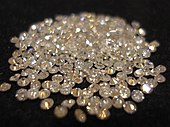
Diamonds were first mined inIndia.[11]Plinymay have mentioned them, although there is some debate as to the exact nature of the stone he referred to asAdamas.[12]In 2005,Australia,Botswana,RussiaandCanadaranked among the primary sources of gemstone diamond production.[13]There are negative consequences of the diamond trade in certain areas. Diamonds mined during the recent civil wars inAngola,Ivory Coast,Sierra Leone,and other nations have been labeled asblood diamondswhen they are mined in a war zone and sold to finance aninsurgency.[14]
TheBritish crown jewelscontain theCullinan Diamond,part of the largest gem-quality rough diamond ever found (1905), at 3,106.75carats(621.35 g).

Now popular inengagement rings,this usage dates back to the marriage ofMaximilian ItoMary of Burgundyin 1477.[15]
A popular style is the diamond solitaire, which features a single large diamond mounted prominently.[16]Within solitaire, there are three categories in which a ring can be classified: prong, bezel and tension setting.[17]
Other gemstones
[edit]Many precious and semiprecious stones are used for jewellery. Among them are:
- Amber
- Amber, an ancientorganic gemstone,is composed of tree resin that has hardened over time. The stone must be at least one million years old to be classified as amber, and some amber can be up to 120 million years old.
- Amethyst
- Amethyst has historically been the most prized gemstone in the quartz family. It is treasured for its purple hue, which can range in tone from light to dark.
- Emerald
- Emeralds are one of the three main precious gemstones (along with rubies and sapphires) and are known for their fine green to bluish-green colour. They have been treasured throughout history, and some historians report that the Egyptians mined emeralds as early as 3500 BC.
- Jade
- Jade is most commonly associated with the colour green but can come in several other colours as well. Jade is closely linked to Asian culture, history, and tradition, and is sometimes referred to as thestone of heaven.
- Jasper
- Jasper is a gemstone of the chalcedony family that comes in a variety of colours. Often, jasper will feature unique and interesting patterns within the coloured stone. Picture jasper is a type of jasper known for the colours (often beiges and browns) and swirls in the stone's pattern.
- Quartz
- Quartz refers to a family of crystalline gemstones of various colours and sizes. Among the well-known types of quartz arerose quartz(which has a delicate pink colour), and smoky quartz (which comes in a variety of shades of translucent brown). Some other gemstones, such asAmethystandCitrine,are also part of the quartz family.Rutilated quartzis a popular type of quartz containing needle-like inclusions.
- Ruby
- Rubies are known for their intense red colour and are among the most highly valued precious gemstones. Rubies have been treasured for millennia. InSanskrit,the word for ruby isratnaraj,meaningking of precious stones.
- Sapphire
- The most popular form of sapphire is blue sapphire, which is known for its medium to deep blue colour and strong saturation. Fancy sapphires of various colours are also available. In the United States, blue sapphire tends to be the most popular and most affordable of the three major precious gemstones (emerald, ruby, and sapphire).
- Turquoise
- Turquoise is found in only a few places on Earth, and the world's largest turquoise-producing region is the southwest United States. Turquoise is prized for its attractive colour, most often an intense medium blue or a greenish blue, and its ancient heritage. Turquoise is used in a great variety of jewellery styles. It is perhaps most closely associated with Southwest and Native American jewellery, but it is also used in many sleek, modern styles. Some turquoise contains a matrix of dark brown markings, which provides an interesting contrast to the gemstone's bright blue colour.
Some gemstones (like pearls, coral, and amber) are classified as organic, meaning that they are produced by living organisms. Others are inorganic, meaning that they are generally composed of and arise from minerals.
Some gems, for example,amethyst,have become less valued as methods of extracting and importing them have progressed. Some man-made gems can serve in place of natural gems, such ascubic zirconia,which can be used in place of diamonds.[18]
Metal finishes
[edit]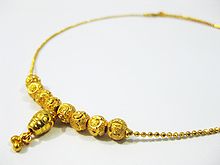
Forplatinum,gold,andsilverjewellery, there are many techniques to create finishes. The most common are high-polish, satin/matte,brushed,and hammered. High-polished jewellery is the most common and gives the metal a highly reflective, shiny look. Satin, or matte finish reduces the shine and reflection of the jewellery, and this is commonly used to accentuate gemstones such asdiamonds.Brushed finishes give the jewellery a textured look and are created by brushing a material (similar to sandpaper) against the metal, leaving "brush strokes". Hammered finishes are typically created using a rounded steel hammer and hammering the jewellery to give it a wavytexture.
Some jewellery is plated to give it a shiny, reflective look or to achieve a desired colour. Sterling silver jewellery may be plated with a thin layer of 0.999 fine silver (a process known as flashing) or plated with rhodium or gold. Base metal costume jewellery may also be plated with silver, gold, or rhodium for a more attractive finish.
Impact on society
[edit]Jewellery has been used to denote status. In ancient Rome, only certain ranks could wear rings and[19]later,sumptuary lawsdictated who could wear what type of jewelry. This was also based on the rank of the citizens of that time.
Cultural dictates have also played a significant role. For example, the wearing of earrings by Western men was considered effeminate in the 19th century and early 20th century. More recently, the display of body jewelry, such aspiercings,has become a mark of acceptance or seen as a badge of courage within some groups but is completely rejected in others. Likewise,hip hopculture has popularised the slang termbling-bling,which refers to the ostentatious display of jewelry by men or women.
Conversely, the jewelry industry in the early 20th century launched a campaign to popularisewedding ringsfor men, which caught on, as well asengagement ringsfor men, which did not, go so far as to create a false history and claim that the practice had medieval roots. By the mid-1940s, 85% of weddings in the U.S. featured a double-ring ceremony, up from 15% in the 1920s.[20]
Some religions have specific rules or traditions surrounding jewelry (or even prohibiting it) and many religions have edicts against excessive display. Islam, for instance, considers the wearing of gold by men asHaraam.[21]The majority of Islamic jewelry was in the form of bridaldowries,and traditionally was not handed down from generation to generation; instead, on a woman's death it was sold at thesoukand recycled or sold to passers-by. Islamic jewelry from before the 19th century is thus exceedingly rare.[22]
History
[edit]The history of jewellery is long and goes back many years, with many different uses among different cultures. It has endured for thousands of years and has provided various insights into how ancient cultures worked.
Prehistory
[edit]The earliest known Jewellery was actually created not by humans (Homo sapiens) but byNeanderthalliving in Europe. Specifically, perforated beads made from small sea shells have been found dating to 115,000 years ago in the Cueva de los Aviones, a cave along the southeast coast of Spain. Later in Kenya, atEnkapune Ya Muto,beads made from perforatedostrichegg shells have been dated to more than 40,000 years ago. In Russia, a stone bracelet and marble ring are attributed to a similar age.[23]
Later, theEuropean early modern humanshad crudenecklacesandbraceletsof bone, teeth, berries, and stone hung on pieces of string or animalsinew,or pieces of carved bone used to secure clothing together. In some cases, jewellery had shell ormother-of-pearlpieces. A decorated engraved pendant (theStar Carr Pendant) dating to around 11,000 BC, and thought to be the oldest Mesolithic art in Britain, was found at the site ofStar CarrinNorth Yorkshirein 2015.[24]In southernRussia,carved bracelets made ofmammothtuskhave been found. TheVenus of Hohle Felsfeatures a perforation at the top, showing that it was intended to be worn as apendant.
Around seven-thousand years ago, the first sign ofcopperjewellery was seen.[8]In October 2012 the Museum of Ancient History in Lower Austria revealed that they had found a grave of a female jewellery worker – forcing archaeologists to take a fresh look at prehistoric gender roles after it appeared to be that of a female fine metal worker – a profession that was previously thought to have been carried out exclusively by men.[25]
-
String of beads; 3650–3100 BC;lapis lazuli(the blue beads) andtravertine(the white beads) (Egyptianalabaster); length: 4.5 centimetres (1.8 in); byNaqada IIorNaqada IIIcultures;Metropolitan Museum of Art(New York City)
-
String of beads; 3300–3100 BC;carnelian,garnet,quartz and glazedsteatite;length: 20.5 centimetres (8.1 in); byNaqada IIIculture Metropolitan Museum of Art
-
Armlet with sun symbol; 16th–13th century BC (lateBronze Age); bronze;German National Museum(Nürnberg)
-
Necklace; probably 2600–1300 BC;carnelian,bone and stone; fromSaruq Al Hadid(theUnited Arab Emirates)
Africa
[edit]Egypt
[edit]The first signs of established jewellery making inAncient Egyptwas around 3,000–5,000 years ago.[26]TheEgyptianspreferred the luxury, rarity, and workability ofgoldover other metals. InPredynastic Egyptjewellery soon began to symbolise political and religious power in the community. Although it was worn by wealthy Egyptians in life, it was also worn by them in death, with jewellery commonly placed amonggrave goods.
In conjunction with gold jewellery, Egyptians used colouredglass,along with semi-precious gems. The colour of the jewellery had significance. Green, for example, symbolised fertility.Lapis lazuliand silver had to be imported from beyond the country's borders.
Egyptian designs were most common inPhoenicianjewellery. Also, ancientTurkishdesigns found inPersianjewellery suggest that trade between the Middle East andEuropewas not uncommon. Women wore elaborate gold and silver pieces that were used in ceremonies.[26]
-
Pectoral (chest jewellery) ofTutankhamun;1336–1327 BC (Reign of Tutankhamun); gold, silver and meteoric glass; height: 14.9 cm (5.9 in);Egyptian Museum(Cairo)
-
Pendant;c. 1069 BC;gold and turquoise; overall: 5.1 by 2.3 centimetres (2.01 in × 0.91 in);Cleveland Museum of Art(Cleveland)
-
Signet ring; 664–525 BC; gold; diameter: 3 by 3.4 centimetres (1.2 in × 1.3 in);British Museum(London)
-
Pectoral and necklace of PrincessSithathoriunet;1887–1813 BC; gold,carnelian,lapis lazuli,turquoise,garnetandfeldspar;height of the pectoral: 4.5 centimetres (1.8 in);Metropolitan Museum of Art(New York City)

Maghreb countries in North Africa
[edit]Jewellery of the Berber culturesis a style of traditional jewellery worn by women and girls in the rural areas of theMaghrebregion inNorth Africainhabited by indigenousBerber people(inBerber language:Amazigh, Imazighen,pl). Following long social and cultural traditions, thesilversmithsof different ethnic Berber groups of Morocco, Algeria and neighbouring countries created intricate jewellery to adorn their women and that formed part of their ethnicidentity.Traditional Berber jewellery was usually made of silver and includes elaborate brooches made of triangular plates and pins (fibula), originally used as clasps for garments, but also necklaces, bracelets, earrings and similar items.
Another major type is the so-calledkhmissa(local pronunciation of theArabicword "khamsa" for the number "five" ), which is calledafusin theBerber language(Tamazight).This form represents the five fingers of the hand and is traditionally believed both byMuslimsas well asJewish peopleto protect against theEvil Eye.[27]
Europe and the Middle East
[edit]The first gold jewellery from Bulgaria
[edit]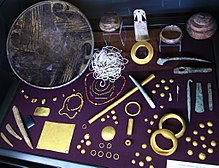
The oldest gold jewelry in the world is dating from 4,600 BC to 4,200 BC and was discovered in Europe, at the site ofVarna Necropolis,near theBlack Seacoast inBulgaria.[28][29][30]
Several prehistoric Bulgarian finds are considered no less old – the golden treasures of Hotnitsa,Durankulak,artifacts from the Kurgan settlement of Yunatsite nearPazardzhik,the golden treasure Sakar, as well as beads and gold jewellery found in the Kurgan settlement ofProvadia–Solnitsata( “salt pit” ). However, Varna gold is most often called the oldest since this treasure is the largest and most diverse.[31]
Mesopotamia
[edit]
By approximately 5,000 years ago, jewellery-making had become a significant craft in the cities ofMesopotamia.The most significant archaeological evidence comes from theRoyal Cemetery of Ur,where hundreds of burials dating 2900–2300 BC were unearthed; tombs such as that ofPuabicontained a multitude of artefacts in gold, silver, and semi-precious stones, such aslapis lazulicrowns embellished with gold figurines, close-fitting collar necklaces, and jewel-headed pins. InAssyria,men and women both wore extensive amounts of jewellery, includingamulets,ankle bracelets, heavy multi-strand necklaces, andcylinder seals.[32]
Jewellery in Mesopotamia tended to be manufactured from thin metal leaf and was set with large numbers of brightly coloured stones (chiefly agate, lapis, carnelian, and jasper). Favoured shapes included leaves, spirals, cones, and bunches of grapes. Jewellers created works both for human use and for adorning statues and idols. They employed a wide variety of sophisticated metalworking techniques, such ascloisonné,engraving,finegranulation,andfiligree.[33]
Extensive and meticulously maintained records pertaining to the trade and manufacture of jewellery have also been unearthed throughout Mesopotamian archaeological sites. One record in theMariroyal archives, for example, gives the composition of various items of jewellery:
- 1 necklace of flat speckled chalcedony beads including: 34 flat speckled chalcedony bead, [and] 35 gold fluted beads, in groups of five.
- 1 necklace of flat speckled chalcedony beads including: 39 flat speckled chalcedony beads, [with] 41 fluted beads in a group that make up the hanging device.
- 1 necklace with rounded lapis lazuli beads including: 28 rounded lapis lazuli beads, [and] 29 fluted beads for its clasp.[34]
-
Sumerian necklace beads; 2600–2500 BC; gold and lapis lazuli; length: 54 centimetres (21 in); Metropolitan Museum of Art
-
Necklace; 2600–2500 BC; gold andlapis lazuli;length: 22.5 centimetres (8.9 in);Royal Cemetery at Ur(Iraq); Metropolitan Museum of Art
-
Pair of earrings with cuneiform inscriptions, 2093–2046 BC; gold;Sulaymaniyah Museum(Sulaymaniyah,Iraq)
-
Sumerian necklaces and headgear discovered in the royal (and individual) graves of the Royal Cemetery at Ur, showing the way they may have been worn, inBritish Museum(London)
Greece
[edit]
The Greeks started using gold and gems in jewellery in 1600 BC, although beads shaped as shells and animals were produced widely in earlier times. Around 1500 BC, the main techniques of working gold in Greece included casting, twisting bars, and making wire.[36]Many of these sophisticated techniques were popular in the Mycenaean period, but unfortunately this skill was lost at the end of the Bronze Age. The forms and shapes of jewellery in ancient Greece such as the armring (13th century BC), brooch (10th century BC) and pins (7th century BC), have varied widely since the Bronze Age as well. Other forms of jewellery include wreaths, earrings, necklace and bracelets. A good example of the high quality that gold working techniques could achieve in Greece is the 'Gold Olive Wreath' (4th century BC), which is modeled on the type of wreath given as a prize for winners in athletic competitions like the Olympic Games. Jewellery dating from 600 to 475 BC is not well represented in the archaeological record, but after the Persian wars the quantity of jewellery again became more plentiful.[37]One particularly popular type of design at this time was a bracelet decorated with snake and animal-heads Because these bracelets used considerably more metal, many examples were made from bronze. By 300 BC, the Greeks had mastered making coloured jewellery and usingamethysts,pearl,andemeralds.Also, the first signs ofcameosappeared, with the Greeks creating them fromIndianSardonyx,a striped brown pink and creamagatestone. Greek jewellery was often simpler than in other cultures, with simple designs and workmanship. However, as time progressed, the designs grew in complexity and different materials were soon used.
Jewellery inGreecewas hardly worn and was mostly used for public appearances or on special occasions. It was frequently given as a gift and was predominantly worn by women to show their wealth, social status, and beauty. The jewellery was often supposed to give the wearer protection from the "Evil Eye"or endowed the owner withsupernatural powers,while others had a religious symbolism. Older pieces of jewellery that have been found were dedicated to the Gods.
They worked two styles of pieces: cast pieces and pieces hammered out of sheet metal. Fewer pieces of cast jewellery have been recovered. It was made by casting the metal onto two stone or clay moulds. The two halves were then joined, andwax,followed by molten metal, was placed in the centre. This technique had been practised since the lateBronze Age.The more common form of jewellery was the hammered sheet type. Sheets of metal would be hammered to thickness and then soldered together. The inside of the two sheets would be filled with wax or another liquid to preserve the metal work. Different techniques, such as using a stamp or engraving, were then used to create motifs on the jewellery. Jewels may then be added to hollows or glass poured into special cavities on the surface.
The Greeks took much of their designs from outer origins, such as Asia, whenAlexander the Greatconquered part of it. In earlier designs, other European influences can also be detected. When Roman rule came to Greece, no change in jewellery designs was detected. However, by 27 BC, Greek designs were heavily influenced by the Roman culture. That is not to say that indigenous design did not thrive. Numerouspolychromebutterfly pendants on silver foxtail chains, dating from the 1st century, have been found nearOlbia,with only one example ever found anywhere else.[38]
-
TheBee Pendant,an iconic Minoan jewel; 1700–1600 BC; gold; width: 4.6 centimetres (1.8 in); from Chrysolakkos (gold pit) complex atMalia;Archaeological Museum of Heraklion(Heraklion,Greece)[39][40]
-
Mycenaean necklace; 1400–1050 BC; gilded terracotta; diameter of the rosettes: 2.7 centimetres (1.1 in), with variations of circa 0.1 centimetres (0.039 in), length of the pendant 3.7 centimetres (1.5 in);Metropolitan Museum of Art(New York City)
-
The Ganymede Jewellery; circa 300 BC; gold; various dimensions; provenance unknown (said to have been found near Thessaloniki, Greece); Metropolitan Museum of Art
-
Necklace; circa 200 BC; gold,moonstone,garnet,emerald,cornelian,baroque pearland bandedagate;overall: 39.4 centimetres (15.5 in);Cleveland Museum of Art(Cleveland)
Etruscan
[edit]Gorgons, pomegranates, acorns, lotus flowers and palms were a clear indicator of Greek influence in Etruscan jewellery. The modelling of heads, which was a typical practice from the Greek severe period, was a technique that spread throughout the Etruscan territory. An even clearer evidence of new influences is the shape introduced in the Orientalizing era: The Bullae. A pear shaped vessel used to hold perfume. Its surface was usually decorated with repoussé and engraved symbolic figures.
Much of the jewellery found was notwornby Etruscans, but were made to accompany them in the after world. Most, if not all, techniques of Etruscan goldsmiths were not invented by them as they are dated to the third millennium BC.
-
TheVulci set of jewelry;early 5th century; gold, glass, rock crystal,agateandcarnelian;various dimensions;Metropolitan Museum of Art(New York City)
-
Earring in the form of a dolphin; 5th century BC; gold; 2.1 by 1.4 by 4.9 centimetres (0.83 in × 0.55 in × 1.93 in); Metropolitan Museum of Art
-
Bulla withDaedalusandIcarus;5th century BC; gold; 1.6 by 1 by 1 centimetre (0.63 in × 0.39 in × 0.39 in);Walters Art Museum(Baltimore)
-
Earring; gold and silver; 1.5 by 0.4 by 1.4 centimetres (0.59 in × 0.16 in × 0.55 in); Metropolitan Museum of Art
Rome
[edit]
Although jewellery work was abundantly diverse in earlier times, especially among the barbarian tribes such as theCelts,when the Romans conquered most of Europe, jewellery was changed as smaller factions developed theRoman designs.The most common artefact of early Rome was thebrooch,which was used to secure clothing together. The Romans used a diverse range of materials for their jewellery from their extensive resources across the continent. Although they used gold, they sometimes used bronze or bone, and in earlier times, glass beads and pearl. As early as 2,000 years ago, they importedSri Lankansapphiresand Indian diamonds and used emeralds andamberin their jewellery. In Roman-ruledEngland,fossilisedwoodcalledjetfrom Northern England was often carved into pieces of jewellery. The early Italians worked in crude gold and created clasps, necklaces, earrings, and bracelets. They also produced largerpendantsthat could be filled withperfume.
Like the Greeks, often the purpose of Roman jewellery was to ward off the "Evil Eye" given by other people. Although women wore a vast array of jewellery, men often only wore a fingerring.Although they were expected to wear at least one ring, some Roman men wore a ring on every finger, while others wore none. Roman men and women wore rings with anengraved gemon it that was used with wax to seal documents, a practice that continued intomedievaltimes whenkingsand noblemen used the same method. After the fall of the Roman Empire, the jewellery designs were absorbed by neighbouring countries and tribes.[26]
-
Cameoportrait of the EmperorAugustus;41–54 AD;sardonyx;3.7 by 2.9 by 0.8 centimetres (1.46 in × 1.14 in × 0.31 in);Metropolitan Museum of Art(New York City)
-
Bracelet; 1st–2nd century AD; gold-mounted crystal and sardonyx; length: 19.69 centimetres (7.75 in);Los Angeles County Museum of Art(Los Angeles)
-
Necklace with a medallion depicting a goddess; 30–300 AD; green glass (the green beads) and gold; length: 43.82 centimetres (17.25 in); Los Angeles County Museum of Art
Middle Ages
[edit]
Post-Roman Europe continued to develop jewellery making skills. TheCeltsandMerovingiansin particular are noted for their jewellery, which in terms of quality matched or exceeded that of theByzantine Empire.Clothing fasteners, amulets, and, to a lesser extent,signet rings,are the most common artefacts known to us. A particularly strikingCeltic exampleis theTara Brooch.[41]TheTorcwas common throughout Europe as a symbol of status and power. By the 8th century, jewelled weaponry was common for men, while other jewellery (with the exception of signet rings) seemed to become the domain of women. Grave goods found in a 6th–7th century burial nearChalon-sur-Saôneare illustrative. A young girl was buried with: 2 silverfibulae,a necklace (with coins), bracelet, gold earrings, a pair of hair-pins, comb, and buckle.[42]TheCeltsspecialised in continuous patterns and designs, while Merovingian designs are best known for stylised animal figures.[43]They were not the only groups known for high quality work. Note the Visigoth work shown here, and the numerous decorative objects found at theAnglo-SaxonShip burialatSutton HooSuffolk,Englandare a particularly well-known example.[26]On the continent,cloisonnéandgarnetwere perhaps the quintessential method and gemstone of the period. In the 15th century, characteristic English jewelry types, such as golden signets and niello rings, became prominent. These pieces were often adorned with tiny figures of saints and intricate floral patterns, rivaling continental designs in craftsmanship.[44]
The Eastern successor of the Roman Empire, theByzantine Empire,continued many of the methods of the Romans, though religious themes came to predominate. Unlike the Romans, the Franks, and the Celts, however, Byzantium used light-weight gold leaf rather than solid gold, and more emphasis was placed on stones and gems. As in the West, Byzantine jewellery was worn by wealthier females, with male jewellery apparently restricted to signet rings. Woman's jewellery had some peculiarities likekoltsthat decoratedheadband. Like other contemporary cultures, jewellery was commonly buried with its owner.[45]
-
TheEagle-shaped fibulae of Alovera;5th century; gold, bronze and glass (imitation of garnet); height: 11.8 centimetres (4.6 in), width: 5.9 centimetres (2.3 in); fromGuadalajara(Spain);National Archaeological Museum(Madrid,Spain)
-
Shoulder-clasps fromSutton Hoo;early 7th century; gold, glass andgarnet;length: 12.7 centimetres (5.0 in);British Museum(London)
-
Pair of Byzantine earrings; 7th century; gold, pearls, glass andemeralds;10.2 by 4.5 centimetres (4.0 in × 1.8 in);Cleveland Museum of Art(Cleveland)
-
Front of a temple pendant with two birds flanking atree of life;11th–12th century;cloisonnéenamel and gold; overall: 5.4 by 4.8 by 1.5 centimetres (2.13 in × 1.89 in × 0.59 in); made inKyiv(Ukraine);Metropolitan Museum of Art(New York City)
Renaissance
[edit]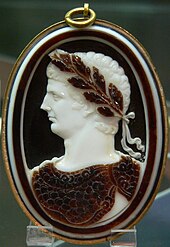
TheRenaissanceand exploration both had significant impacts on the development of jewellery in Europe. By the 17th century, increasing exploration and trade led to increased availability of a wide variety of gemstones as well as exposure to the art of other cultures. Whereas prior to this the working of gold and precious metal had been at the forefront of jewellery, this period saw increasing dominance of gemstones and their settings. An example of this is theCheapside Hoard,the stock of a jeweller hidden inLondonduring theCommonwealthperiod and not found again until 1912. It contained Colombianemerald,topaz,amazonitefrom Brazil,spinel,iolite,andchrysoberylfrom Sri Lanka,rubyfrom India, Afghanlapis lazuli,Persianturquoise,Red Seaperidot,as well as Bohemian and Hungarianopal,garnet,andamethyst.Large stones were frequently set in box-bezels on enamelled rings.[46]Notable among merchants of the period wasJean-Baptiste Tavernier,who brought the precursor stone of theHope Diamondto France in the 1660s.
WhenNapoleon Bonapartewas crowned as Emperor of the French in 1804, he revived the style and grandeur of jewellery and fashion in France. Under Napoleon's rule, jewellers introducedparures,suites of matching jewellery, such as a diamondtiara,diamondearrings,diamond rings, a diamond brooch, and a diamond necklace. Both of Napoleon's wives had beautiful sets such as these and wore them regularly. Another fashion trend resurrected by Napoleon was thecameo.Soon after his cameo decorated crown was seen, cameos were highly sought. The period also saw the early stages ofcostume jewellery,withfish scalecovered glass beads in place ofpearlsorconchshell cameos instead of stone cameos. New terms were coined to differentiate the arts: jewellers who worked in cheaper materials were calledbijoutiers,while jewellers who worked with expensive materials were calledjoailliers,a practice which continues to this day.
Romanticism
[edit]
Starting in the late 18th century,Romanticismhad a profound impact on the development of western jewellery. Perhaps the most significant influences were the public's fascination with the treasures being discovered through the birth of modernarchaeologyand a fascination with Medieval and Renaissance art. Changing social conditions and the onset of theIndustrial Revolutionalso led to growth of a middle class that wanted and could afford jewellery. As a result, the use of industrial processes, cheaper alloys, and stone substitutes led to the development of paste orcostume jewellery.Distinguished goldsmiths continued to flourish, however, as wealthier patrons sought to ensure that what they wore still stood apart from the jewellery of the masses, not only through use of precious metals and stones but also though superior artistic and technical work. One such artist was the French goldsmithFrançois-Désiré Froment-Meurice.A category unique to this period and quite appropriate to the philosophy of romanticism was mourning jewellery. It originated in England, whereQueen Victoriawas often seen wearingjetjewellery after the death ofPrince Albert,and it allowed the wearer to continue wearing jewellery while expressing a state of mourning at the death of a loved one.[47]
In the United States, this period saw the founding in 1837 ofTiffany & Co.byCharles Lewis Tiffany.Tiffany's put the United States on the world map in terms of jewellery and gained fame creating dazzling commissions for people such as the wife ofAbraham Lincoln.Later, it would gain popular notoriety as the setting of the filmBreakfast at Tiffany's.In France,Pierre CartierfoundedCartier SAin 1847, while 1884 saw the founding ofBulgariin Italy. The modern production studio had been born and was a step away from the former dominance of individual craftsmen andpatronage.
This period also saw the first major collaboration between East and West. Collaboration inPforzheimbetween German and Japanese artists led toShakudōplaques set intoFiligreeframes being created by the Stoeffler firm in 1885).[48]Perhaps the grand finalé – and an appropriate transition to the following period – were the masterful creations of the Russian artistPeter Carl Fabergé,working for the Imperial Russian court, whoseFabergé eggsand jewellery pieces are still considered as the epitome of the goldsmith's art.
18th century/Romanticism/Renaissance
[edit]Many whimsical fashions were introduced in the extravagant eighteenth century. Cameos that were used in connection with jewellery were the attractive trinkets along with many of the small objects such as brooches, ear-rings and scarf-pins. Some of the necklets were made of several pieces joined with the gold chains were in and bracelets were also made sometimes to match the necklet and the brooch. At the end of the Century the jewellery with cut steel intermixed with large crystals was introduced by an Englishman, Matthew Boulton of Birmingham.[49]
Art Nouveau
[edit]
In the 1890s, jewellers began to explore the potential of the growingArt Nouveaustyle and the closely related GermanJugendstil,British (and to some extent American)Arts and Crafts Movement,CatalanModernisme,Austro-HungarianSezession,Italian "Liberty", etc.
Art Nouveau jewellery encompassed many distinct features including a focus on the female form and an emphasis on colour, most commonly rendered through the use of enamelling techniques including basse-taille, champleve, cloisonné, andplique-à-jour.Motifs included orchids, irises, pansies, vines, swans, peacocks, snakes, dragonflies, mythological creatures, and the female silhouette.
René Lalique,working for the Paris shop ofSamuel Bing,was recognised by contemporaries as a leading figure in this trend. TheDarmstadt Artists' ColonyandWiener Werkstätteprovided perhaps the most significant input to the trend, while in DenmarkGeorg Jensen,though best known for hisSilverware,also contributed significant pieces. In England,Liberty & Co.,(notably through theCymricdesigns ofArchibald Knox) and the British arts and crafts movement ofCharles Robert Ashbeecontributed slightly more linear but still characteristic designs. The new style moved the focus of the jeweller's art from the setting of stones to the artistic design of the piece itself. Lalique'sdragonflydesign is one of the best examples of this.Enamelsplayed a large role in technique, while sinuous organic lines are the most recognisable design feature.
The end ofWorld War Ionce again changed public attitudes, and a more sober style developed.[50]
-
TheDragonfly brooch;byRené Lalique;c. 1897–1898; gold,vitreous enamel,chrysoprase,chalcedony,moonstoneand diamond; height: 23 centimetres (9.1 in), width: 26.5 centimetres (10.4 in);Calouste Gulbenkian Museum(Lisboa,Portugal)
-
Necklace; by René Lalique; 1897–1899; gold,enamel,opalsandamethysts;overall diameter: 24.1 centimetres (9.5 in);Metropolitan Museum of Art(New York City)
-
TheSnakes brooch;by René Lalique; gold and enamel; Calouste Gulbenkian Museum
-
Hair ornament, anArt Nouveaumasterpiece; by René Lalique;c. 1902;gold, emeralds and diamonds;Musée d'Orsay(Paris)
Art Deco
[edit]
Growing political tensions, the after-effects of the war, and a reaction against the perceived decadence of the turn of the 20th century led to simpler forms, combined with more effective manufacturing for mass production of high-quality jewellery. Covering the period of the 1920s and 1930s, the style has become popularly known asArt Deco.Walter Gropiusand the GermanBauhausmovement, with their philosophy of "no barriers between artists and craftsmen" led to some interesting and stylistically simplified forms. Modern materials were also introduced: plastics and aluminium were first used in jewellery, and of note are the chromed pendants of Russian-born Bauhaus masterNaum Slutzky.Technical mastery became as valued as the material itself. In the West, this period saw the reinvention of granulation by the GermanElizabeth Treskow,although development of the re-invention has continued into the 1990s. It is based on the basic shapes.
Asia
[edit]In Asia, theIndian subcontinenthas the longest continuous legacy of jewellery making anywhere, Asia was the first place where these jewellery were made in large numbers for the royals[51]with a history of over 5,000 years.[52]One of the first to start jewellery making were the peoples of theIndus Valley civilization,in what is now predominately modern-day Pakistan and part of northern and western India. Early jewellery making inChinastarted around the same period, but it became widespread with the spread ofBuddhismaround 2,000 years ago.
China
[edit]The Chinese usedsilverin their jewellery more than gold. Bluekingfisherfeatherswere tied onto early Chinese jewellery and later, blue gems and glass were incorporated into designs. However,jadewas preferred over any other stone. The Chinese revered jade because of the human-like qualities they assigned to it, such as its hardness, durability, and beauty.[8]The first jade pieces were very simple, but as time progressed, more complex designs evolved. Jade rings from between the 4th and 7th centuries BC show evidence of having been worked with a compoundmilling machine,hundreds of years before the first mention of such equipment in the west.[53]
In China, the most uncommon piece of jewellery is the earring, which was worn neither by men nor women.[54]In modern times, earrings are still considered culturally taboo for men in China—in fact, in 2019, the Chinese video streaming serviceiQiyibegan blurring the ears of male actors wearing earrings.Amuletswere common, often with a Chinese symbol ordragon.Dragons, Chinese symbols, andphoenixeswere frequently depicted on jewellery designs.
The Chinese often placed their jewellery in their graves. Most Chinese graves found byarchaeologistscontain decorative jewellery.[55]
-
Fluted ring with a dragon head (huan); circa 475 BC; jade (nephrite); overall: 9.1 centimetres (3.6 in);Cleveland Museum of Art(Cleveland)
-
Ornament with flowers and grapes design; 1115–1234; jade;Shanghai Museum(China)
-
Hat ornament; 18th–19th century; gold, gilded metal, kingfisher feathers, glass and semiprecious stones; various dimensions;Metropolitan Museum of Art(New York City)
Indian subcontinent
[edit]

TheIndian subcontinenthas a long jewellery history, which has gone through various changes via cultural influence and politics for more than 5,000–8,000 years. Because India had an abundant supply of precious metals and gems, it prospered financially through export and exchange with other countries. While European traditions were heavily influenced by waxing and waning empires, India enjoyed a continuous development of art forms for some 5,000 years.[52]One of the first to start jewellery making were the peoples of theIndus Valley civilization.By 1500 BC, the peoples of the Indus Valley were creating gold earrings and necklaces, bead necklaces, and metallicbangles.Before 2100 BC, prior to the period when metals were widely used, the largest jewellery trade in the Indus Valley region was thebeadtrade. Beads in the Indus Valley were made using simple techniques. First, a bead maker would need a rough stone, which would be bought from an eastern stone trader. The stone would then be placed into a hot oven where it would be heated until it turned deep red, a colour highly prized by people of the Indus Valley. The red stone would then be chipped to the right size and a hole bored through it with primitive drills. The beads were then polished. Some beads were also painted with designs. This art form was often passed down through the family. Children of bead makers often learned how to work beads from a young age. Each stone had its own characteristics related to Hinduism.
Jewellery in theIndus Valley Civilizationwas worn predominantly by females, who wore numerous clay or shell bracelets on their wrists. They were often shaped like doughnuts and painted black. Over time, clay bangles were discarded for more durable ones. In present-dayIndia,bangles are made out ofmetalor glass.[56]Other pieces that women frequently wore were thin bands of gold that would be worn on the forehead, earrings, primitive brooches,chokers,and gold rings. Although women wore jewellery the most, some men in the Indus Valley wore beads. Small beads were often crafted to be placed in men and women's hair. The beads were about one millimetre long.
A female skeleton (presently on display at the National Museum, New Delhi, India) wears a carlinean bangle (bracelet) on her left hand.Kadais a special kind of bracelet and is widely popular in Indian culture. They symbolize animals such as peacock, elephant, etc.[57]
According to Hindu belief, gold and silver are considered as sacred metals. Gold is symbolic of the warm sun, while silver suggests the cool moon. Both are the quintessential metals of Indian jewellery. Pure gold does not oxidise or corrode with time, which is why Hindu tradition associates gold with immortality. Gold imagery occurs frequently in ancient Indian literature. In the Vedic Hindu belief of cosmological creation, the source of physical and spiritual human life originated in and evolved from a golden womb (hiranyagarbha) or egg (hiranyanda), a metaphor of the sun, whose light rises from the primordial waters.[58]
Jewellery had great status with India's royalty; it was so powerful that they established laws, limiting wearing of jewellery to royalty. Only royalty and a few others to whom they granted permission could wear gold ornaments on their feet. This would normally be considered breaking the appreciation of the sacred metals. Even though the majority of the Indian population wore jewellery,Maharajasand people related to royalty had a deeper connection with jewellery. TheMaharaja's role was so important that the Hindu philosophers identified him as central to the smooth working of the world. He was considered as a divine being, a deity in human form, whose duty was to uphold and protect dharma, the moral order of the universe.[59]The largest ever single order toCartierwas made in 1925 by theIndian royalty,theMaharaja of Patiala,for thePatiala Necklaceand other jewelry worth₹1,000 million(equivalent to₹210 billion, US$2.6 billion or €2.6 billion in 2023).[60]
Navaratna(nine gems) is a powerful jewel frequently worn by aMaharaja(Emperor). It is an amulet, which comprises diamond, pearl, ruby, sapphire, emerald, topaz, cat's eye, coral, and hyacinth (red zircon). Each of these stones is associated with a celestial deity, represented the totality of the Hindu universe when all nine gems are together. The diamond is the most powerful gem among the nine stones. There were various cuts for the gemstone. Indian Kings bought gemstones privately from the sellers. Maharaja and other royal family members value gem as Hindu God. They exchanged gems with people to whom they were very close, especially the royal family members and other intimate allies.
Indiawas the first country to minediamonds,with some mines dating back to 296 BC. India traded the diamonds, realising their valuable qualities. Historically, diamonds have been given to retain or regain a lover's or ruler's lost favour, as symbols of tribute, or as an expression of fidelity in exchange for concessions and protection. Mughal emperors and Kings used the diamonds as a means of assuring their immortality by having their names and worldly titles inscribed upon them. Moreover, it has played and continues to play a pivotal role in Indian social, political, economic, and religious event, as it often has done elsewhere. In Indian history, diamonds have been used to acquire military equipment, finance wars, foment revolutions, and tempt defections. They have contributed to the abdication or the decapitation of potentates. They have been used to murder a representative of the dominating power by lacing his food with crushed diamond. Indian diamonds have been used as security to finance large loans needed to buttress politically or economically tottering regimes. Victorious military heroes have been honoured by rewards of diamonds and also have been used as ransom payment for release from imprisonment or abduction.[61]
Today, many jewellery designs and traditions are used, and jewellery is commonplace in Indian ceremonies andweddings.[55]For many Indians, especially those who follow theHinduorJainfaiths, bridal jewellery is known asstreedhanand functions as personal wealth for the bride only, as a sort of financial security. For this reason, this jewellery, especially in the sacred metals of gold and silver, has large cultural significance for Indian brides. Jewellery is worn on the arms and hands, ears, neck, hair, head, feet, toes and waist to bless the bride with prosperity.[62]
-
Pendant probably withSiddha;8th–9th century; copper alloy; 8.89 by 7.93 by 0.31 centimetres (3.50 in × 3.12 in × 0.12 in);Los Angeles County Museum of Art(Los Angeles)
-
Earring withVishnuridingGaruda;c. 1600;gold set with jewels and semi-precious stones; overall: 2.6 centimetres (1.0 in); fromNepal;Cleveland Museum of Art(Cleveland)
-
Earring with four-armed Vishnu riding Garuda withNagas(serpent divinities);c. 1600;repousse gold with pearls; overall: 3.6 cm; from Nepal; Cleveland Museum of Art
-
Comb with Vishnu adored by serpents; 1750–1800; ivory with traces of paint; 6.99 by 7.94 centimetres (2.75 in × 3.13 in); from Nepal; Los Angeles County Museum of Art
North and South America
[edit]
Jewellery making started in the Americas with the arrival ofPaleo-Indiansmore than 15,000 years ago. This jewellery would have been made from stone, shell, bone and other perishable materials. The American continent is home to 2cradles of civilization:in theAndesandMesoamerica.Cultures in these regions developed more complex methods of jewellery creation. The Andes is the origin ofhot workingmetallurgyin the Americas and consequently the region has the longest history of work in materials such as silver, platinum and gold. Metallurgy began in Mesoamerica during the Termainal Classic era, likely arriving from direct maritime trade with the Andean cultures. As a result, western Mesoamerican cultures, such as theTarascansandMixtecs,had more complex use of the technology.
With theMocheculture, goldwork flourished. The pieces are no longer simple metalwork, but are now masterful examples of jewellery making. Pieces are sophisticated in their design, and feature inlays of turquoise, mother of pearl, spondylus shell, and amethyst. The nose and ear ornaments, chest plates, small containers and whistles are considered masterpieces of ancient Peruvian culture.[63] A notable example of Andean metallurgy is the Northern Andean cultures' work withplatinum,which has a much highermelting pointthan other precious metals. There are only a few known examples ofcold workedplatinum in theOld Worldand no known intentionally hot worked examples (platinum was not identified as a separate element and small inclusions appeared in some goldwork). In the New World however, certain Andean cultures recognized platinum as a separate metal and were able to incorporate it into jewellery, such as throughsinteringit with gold.[64]

Among the Late Post-Classic Aztecs, only nobility wore gold jewellery, as it showed their rank, power, and wealth. A large portion of "Aztec gold" jewellery was created by Mixtec artisans. The Mixtecs were particularly known for their goldwork and gold jewellery was part of the tribute paid by Mixtec polities to the Aztecs. In general, the more jewellery an Aztec noble wore, the higher his status or prestige.The Emperorand his High Priests, for example, would be nearly completely covered in jewellery when making public appearances. Although gold was the most common and a popular material used in Aztec jewellery,jade,turquoise,and certain feathers were considered more valuable.[65]In addition to adornment and status, the Aztecs also used jewellery in sacrifices to appease the gods.[26][47]
Another ancient American civilization with expertise in jewellery making were theMaya.During the Pre-Classic and Classic era of Maya civilization, the Maya were making jewellery from local materials such as jade, pearls, and sea shell while also incorporating imported materials such as obsidian and turquoise. In the Terminal Classic and Post-Classic, importation of gold, silver,bronze,andcopperlead to the use of these materials in jewellery. Merchants and nobility were the only few that wore expensive jewellery in the Maya region, much the same as with the Aztecs.[55]Jade in particular had an importantrole across Mesoamerica.
InNorthern America,Native Americans usedshells,wood, turquoise, andsoapstoneThe turquoise was used in necklaces and to be placed in earrings. The turquoise incorporated into Mesoamerican jewellery was primarily obtained through trade withOasisamerica.Native Americans with access tooystershells, often located in only one location in America, traded the shells with other tribes, showing the great importance of the body adornment trade in Northern America.[66]
Jewellery played a major role in the fate of theAmericaswhen theSpanish colonizerswere spurred to search for gold on the American mainland after coming into contact with Caribbean natives that had gold jewellery obtained through trade with the mainland. Continued contact with Native Americans wearing gold jewellery eventually lead to Spanish expeditions of the mythologicalEl Dorado.
-
Pendant made from aspondylusshell,Western Mexico shaft tomb tradition,200 BC to 200 AD, now at theArt Institute of Chicago,United States.
-
Muiscagold jewellery, including a headband, nose ornament and pectoral, on display at theGold Museumin Bogota, Colombia.
-
Moche nose ornament made from silver and gold-silveralloy,inlaid withmalachite,now at theCleveland Museum of Art,United States.
-
Mixtec-Puebla stylelabretmade from obsidian in the shape of an eagle, now at theWalters Art Museumin Baltimore, United States.
Native American
[edit]
Native American jewelleryis the personal adornment, often in the forms of necklaces, earrings, bracelets, rings, pins, brooches, labrets, and more, made by theIndigenous peoples of the United States.Native American jewellery reflects the cultural diversity and history of its makers.Native American tribescontinue to develop distinct aesthetics rooted in their personal artistic visions and cultural traditions. Artists create jewellery for adornment, ceremonies, and trade. Lois Sherr Dubin writes, "[i]n the absence of written languages, adornment became an important element of Indian [Native American] communication, conveying many levels of information." Later, jewellery and personal adornment "...signaled resistance to assimilation. It remains a major statement of tribal and individual identity."[67]
Within the Haida Nation of the Pacific Northwest, copper was used as a form of jewellery for creating bracelets.[68]
Metalsmiths, beaders, carvers, and lapidaries combine a variety of metals, hardwoods, precious and semi-precious gemstones,beadwork,quillwork,teeth, bones, hide, vegetal fibres, and other materials to create jewellery. Contemporary Native American jewellery ranges from hand-quarried and processed stones and shells to computer-fabricated steel and titanium jewellery.
Pacific
[edit]Jewellery making in thePacificstarted later than in other areas because of recent human settlement. Early Pacific jewellery was made of bone, wood, and other natural materials, and thus has not survived. Most Pacific jewellery is worn above the waist, with headdresses, necklaces, hair pins, and arm and waist belts being the most common pieces.
Jewellery in the Pacific, with the exception of Australia, is worn to be a symbol of either fertility or power. Elaborate headdresses are worn by many Pacific cultures and some, such as the inhabitants ofPapua New Guinea,wear certain headdresses once they have killed an enemy. Tribesman may wear boar bones through their noses.
Island jewellery is still very much primal because of the lack of communication with outside cultures. Some areas of Borneo and Papua New Guinea are yet to be explored by Western nations. However, the island nations that were flooded with Western missionaries have had drastic changes made to their jewellery designs. Missionaries saw any type of tribal jewellery as a sign of the wearer's devotion to paganism. Thus many tribal designs were lost forever in the mass conversion to Christianity.[69]
Australiais now the number one supplier ofopalsin the world. Opals had already been mined in Europe and South America for many years prior, but in the late 19th century, the Australian opal market became predominant. Australian opals are only mined in a few select places around the country, making it one of the most profitable stones in the Pacific.[70]
TheNew ZealandMāoritraditionally had a strong culture of personal adornment,[71]most famously thehei-tiki.Hei-tikis are traditionally carved by hand from bone,nephrite,orbowenite.
Nowadays a wide range of such traditionally inspired items such as bone carved pendants based on traditional fishhookshei matauand othergreenstonejewellery are popular with young New Zealanders of all backgrounds – for whom they relate to a generalized sense of New Zealand identity. These trends have contributed towards a worldwide interest in traditional Māori culture and arts.
Other than jewellery created through Māori influence, modern jewellery in New Zealand is multicultural and varied.[69]
-
Māorihei-tiki;1500–1800; jade (nephrite), abalone shell and pigments; from theNew Zealand;Musée du quai Branly – Jacques Chirac(Paris)
-
Hei-tiki;18th century; nephrite and haliotis shell; 10.9 centimetres (4.3 in); from the New Zealand;Los Angeles County Museum of Art(Los Angeles)
-
Hawaiian pendant; 18th–19th century; whalebone; height: 6 centimetres (2.4 in), width, 3.8 centimetres (1.5 in);Metropolitan Museum of Art(New York City)
-
Breast Ornament (civa vonovono);c. 1850;whale ivory, pearl shell and fiber; height: 12.7 centimetres (5.0 in), diameter: 17.78 centimetres (7.00 in); fromFiji;Los Angeles County Museum of Art
Modern
[edit]

Most modern commercial jewellery continues traditional forms and styles, but designers such asGeorg Jensenhave widened the concept of wearable art. The advent of new materials, such as plastics,Precious Metal Clay(PMC), and colouring techniques, has led to increased variety in styles. Other advances, such as the development of improvedpearlharvesting by people such asMikimoto Kōkichiand the development of improved quality artificial gemstones such asmoissanite(adiamond simulant), has placed jewellery within the economic grasp of a much larger segment of the population.
The"jewellery as art"movement was spearheaded by artisans such asRobert Lee Morrisand continued by designers such as Gill Forsbrook in the UK. Influence from other cultural forms is also evident. One example of this isbling-blingstyle jewellery, popularised by hip-hop and rap artists in the early 21st century, e.g.grills,a type of jewellery worn over the teeth.

The late 20th century saw the blending of European design with oriental techniques such asMokume-gane.The following are innovations in the decades straddling the year 2000: "Mokume-gane, hydraulic die forming, anti-clasticraising,fold-forming,reactive metal anodising, shell forms,PMC,photoetching,and [use of]CAD/CAM."[72]
Also,3D printingas a production technique gains more and more importance. With a great variety of services offering this production method, jewellery design becomes accessible to a growing number of creatives. An important advantage of using 3d printing are the relatively low costs forprototypes,small batch series or unique andpersonalizeddesigns. Shapes that are hard or impossible to create by hand can often be realized by 3D printing. Popular materials to print includepolyamide,steelandwax(latter for further processing). Every printable material has its very own constraints that have to be considered while designing the piece of jewellery using3D modelling software.
Artisan jewellerycontinues to grow as both a hobby and a profession. With more than 17 United States periodicals about beading alone, resources, accessibility, and a low initial cost of entry continues to expand production of hand-made adornments. Some fine examples of artisan jewellery can be seen atThe Metropolitan Museum of ArtinNew York City.[73] The increase in numbers of students choosing to study jewellery design and production in Australia has grown in the past 20 years, and Australia now has a thriving contemporary jewellery community. Many of these jewellers have embraced modern materials and techniques, as well as incorporating traditional workmanship.
More expansive use of metal to adorn the wearer, where the piece is larger and more elaborate than what would normally be considered jewellery, has come to be referred to by designers and fashion writers asmetal couture.[74][75]
Masonic
[edit]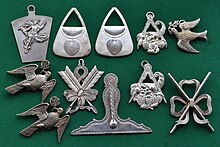
Freemasonsattach jewels to their detachable collars when in Lodge to signify a Brothers Office held with the Lodge. For example, the square represents the Master of the Lodge and the dove represents the Deacon.
Body modification
[edit]
Jewellery used inbody modificationcan be simple and plain or dramatic and extreme. The use of simple silver studs, rings, and earrings predominates. Common jewellery pieces such as earrings are a form of body modification, as they are accommodated by creating a small hole in the ear.
Padaungwomen inMyanmarplace large golden rings around their necks. From as early as five years old, girls are introduced to their first neck ring. Over the years, more rings are added. In addition to the twenty-plus pounds of rings on her neck, a woman will also wear just as many rings on her calves. At their extent, some necks modified like this can reach 10–15 in (25–38 cm) long. The practice has health impacts and has in recent years declined from cultural norm to tourist curiosity.[76]Tribes related to the Padaung, as well as other cultures throughout the world, use jewellery to stretch their earlobes or enlarge ear piercings. In the Americas,labretshave been worn since beforefirst contactbyInnuandFirst Nationspeoples of the northwest coast.[77]Lip plateshave been worn by the AfricanMursiandSara people,as well as some South American peoples.
In the late twentieth century, the influence ofmodern primitivismled to many of these practices being incorporated into western subcultures. Many of these practices rely on a combination of body modification and decorative objects, thus keeping the distinction between these two types of decoration blurred.
In many cultures, jewellery is used as a temporary body modifier; in some cases, with hooks or other objects being placed into the recipient's skin. Although this procedure is often carried out by tribal or semi-tribal groups, often acting under a trance during religious ceremonies, this practice has seeped into western culture. Many extreme-jewellery shops now cater to people wanting large hooks or spikes set into their skin. Most often, these hooks are used in conjunction with pulleys to hoist the recipient into the air. This practice is said to give an erotic feeling to the person and some couples have even performed their marriage ceremony whilst being suspended by hooks.[76]
Jewellery market
[edit]
According to a 2007 KPMG study,[78]the largest jewellery market is the United States with a market share of 31%, Japan, India, China, and the Middle East each with 8–9%, and Italy with 5%. The authors of the study predicted a dramatic change in market shares by 2015, where the market share of the United States will have dropped to around 25%, and China and India will increase theirs to over 13%. The trend of buying jewellery online is also increasing day by day. The Middle East will remain more or less constant at 9%, whereas Europe's and Japan's market share will be halved and become less than 4% for Japan, and less than 3% for the biggest individual European countries, Italy and the UK.
See also
[edit]References
[edit]- ^Study reveals 'oldest jewellery'Archived2018-06-12 at theWayback Machine,BBC News,June 22, 2006.
- ^jewel. (n.d.).Archived2016-03-07 at theWayback MachineDictionary.com Unabridged (v 1.1). Retrieved on August 7, 2007, from the Dictionary.com website.
- ^seeAmerican and British spelling differences
- ^Kunz, George Frederick (1917).Magic of Jewels and Charms.John Lippincott Co.URL:Magic Of jewels: Chapter VII AmuletsArchived2013-12-13 at theWayback MachineGeorge Frederick Kunz,a gemmologist for Tiffany's, built the collections of banker J.P. Morgan and of the American Natural History Museum in New York City. This chapter deals entirely with using jewels and gemstones in jewellery for talismanic purposes in Western cultures.
- ^
Manutchehr-Danai, Mohsen, ed. (2009). "magical jewelry".Dictionary of Gems and Gemology.Berlin: Springer.doi:10.1007/978-3-540-72816-0.ISBN978-3-540-72795-8.
magical jewelry [...] articles of jewelry worn for their magical belief, medicinal powers, or superstitions reasons.
- ^"BBC – History – Ancient History in depth: Viking Money".Archivedfrom the original on 2014-02-10.Retrieved2017-11-10.
- ^Web Team, Victoria and Albert Museum, Online Museum (2011-01-13)."Trade Beads".www.vam.ac.uk.Archivedfrom the original on 2022-01-08.Retrieved2017-11-10.
{{cite web}}:CS1 maint: multiple names: authors list (link) - ^abcHolland, J. 1999. The Kingfisher History Encyclopedia.Kingfisher books.
- ^ Morris, Desmond.Body Guards: Protective Amulets and Charms.Element, 1999,ISBN1862045720.
- ^McCreight, Tim.Jewelry: Fundamentals of Metalsmithing.Design Books International, 1997,ISBN1880140292.
- ^"Home – GIA.edu"(PDF).gia.edu.Archived fromthe original(PDF)on 2007-09-26.
- ^Pliny.Natural History,XXXVI, 15
- ^"Natural Diamond: World Production, By Country And Type".indexmundi.com.Archivedfrom the original on 2018-06-25.Retrieved2007-08-07.
- ^"How the African Diamond Trade Works".HowStuffWorks.2008-04-21.Retrieved2024-01-22.
- ^"Diamonds Are a Girl's Worst Friend: The trouble with engagement rings".Archived2011-09-24 at theWayback Machine.by Meghan O'Rourke at Slate.com, June 11, 2007.
- ^"What is a Solitaire Setting".GIA.edu.Gemological Institute of America. 6 June 2012.Archivedfrom the original on 21 December 2019.Retrieved21 December2019.
- ^"What does solitaire ring look like?".TIDAN.tidanapp.com. Archived fromthe originalon 5 December 2021.Retrieved6 May2020.
- ^Nassau, K. (1980).Gems made by man.ISBN0801967732.
- ^Pliny the Elder.The Natural History.ed.John Bostock,Henry Thomas Riley,Book XXXIIIThe Natural History of MetalsOnline at the Perseus ProjectArchived2008-04-11 at theWayback MachineChapter 4. Accessed July 2006
- ^Howard, Vicky. "A Real Man's Ring: Gender and the Invention of Tradition."Journal of Social History,Summer 2003, pp 837–856.
- ^Yusuf al-Qaradawi.The Lawful and Prohibited in Islam (online)Archived2011-10-13 at theWayback Machine
- ^Greenbaum, Toni. "Silver Speaks: Traditional Jewelry From the Middle East".Metalsmith,Winter 2004, Vol. 24, Issue 1, p. 56. Greenbaum explains the lack of historical examples
- ^"Stone Bracelet May Have Been Made by Denisovans".2015.Archivedfrom the original on 2018-09-25.Retrieved2015-05-10.
A stone bracelet unearthed in Denisova Cave in the Altai Mountains of Siberia in 2008 is being called the oldest-known jewelry of its kind. Anatoly Derevyanko, director of the Russian Academy of Sciences' Institute of Archaeology and Ethnography, and the research team believe that the cave's Denisovan layers were uncontaminated by human activity from a later period. The soil around the two fragments of the jewelry piece was dated with oxygen isotopic analysis to 40,000 years ago. "In the same layer, where we found a Denisovan bone, were found interesting things; until then it was believed these were the hallmark of the emergence of Homo sapiens. First of all, there were symbolic items, such as jewelry, including the stone bracelet as well as a ring, carved out of marble," Derevyanko told The Siberian Times
- ^Milner, Nicky (2016)."A Unique Engraved Shale Pendant from the Site of Star Carr: the oldest Mesolithic art in Britain"(PDF).Internet Archaeology(40).doi:10.11141/ia.40.8.Archived(PDF)from the original on 2018-07-22.
- ^The Austrian Independent News and Pictures."Cavewoman jeweller rewrites gender history".austrianindependent.com.Archived fromthe originalon 2012-10-07.Retrieved2012-10-05.
- ^abcdeReader's Digest Association. 1986. The last 2 million years.Reader's Digest.ISBN0864380070
- ^Camps-Fabrer, Henriette (1991-12-01)."Bijoux".Encyclopédie berbère(in French) (10): 1496–1516.doi:10.4000/encyclopedieberbere.1758.ISSN1015-7344.Archivedfrom the original on 2023-07-18.Retrieved2023-12-08.
- ^[1]Archived2022-11-01 at theWayback MachineGems and Gemstones: Timeless Natural Beauty of the Mineral World, By Lance Grande
- ^(https://www.smithsonianmag.com/travel/varna-bulgaria-gold-graves-social-hierarchy-prehistoric-archaelogy-smithsonian-journeys-travel-quarterly-180958733/Archived2023-07-18 at theWayback Machine)
- ^(https://www.smithsonianmag.com/smart-news/oldest-gold-object-unearthed-bulgaria-180960093/Archived2019-09-28 at theWayback Machine)
- ^"Archaeologists have discovered the oldest treasure in the world – Afrinik".15 May 2021.Archivedfrom the original on 26 December 2021.Retrieved8 December2023.
- ^Nemet-Nejat,Daily Life,155–157.
- ^Nemet-Nejat,Daily Life,295–297.
- ^Nemet-Nejat,Daily Life,297.
- ^Smith, David Michael (2017).Ancient Greece Pocket Museum.Thames and Hudson. p. 251.ISBN978-0500519585.
- ^Jewellery Through 7000 Years.British Museum Publications. 1976. pp.65–86.ISBN978-0714100548.
- ^Deppert-Lippitz, Barbara; Bromberg, Anne R.; Dennis, John (1996)."Ch. 4 Europe and Western".Ancient Gold Jewelry at the Dallas Museum of Art.Dallas Museum of Art. pp. 88–89.ISBN978-0936227191.
- ^Treister, Mikhail (2004). "Polychrome Necklaces from the Late Hellenistic Period".Ancient Civilizations from Scythia to Siberia.10(3): 199–257.doi:10.1163/1570057042596388.
- ^Smith, David Michael (2017).Ancient Greece Pocket Museum.Thames and Hudson. p. 79.ISBN978-0500519585.
- ^Nelson, E. C., Mavrofridis, G., & Anagnostopoulos, I. T. (2020). "Natural History of a Bronze Age Jewel Found in Crete: The Malia Pendant".The Antiquaries Journal,1–12.doi:10.1017/S0003581520000475
- ^Somerville, Orna. "Kite-Shaped Brooches".Journal of the Royal Society of Antiquaries of Ireland,volume 123, 1993. pp. 59–101.JSTOR25509045
- ^Duby Georges and Philippe Ariès, eds.A History of Private LifeVol 1 – From Pagan Rome to Byzantium. Harvard, 1987. p 506
- ^Duby, throughout.
- ^"Jewellery and silverware".HathiTrust.Retrieved2024-09-25.
- ^Sherrard, P. (1972).Great Ages of Man: Byzantium.Time-Life International.
- ^Scarisbrick, Diana.Rings: Symbols of Wealth, Power, and Affection.New York: Abrams, 1993.ISBN0810937751p. 77.
- ^abFarndon, J. (2001).1,000 Facts on Modern History.Miles Kelly Publishing.
- ^Ilse-Neuman, Ursula.Book reviewSchmuck/Jewellery 1840–1940: Highlights from the Schmuckmuseum Pforzheim.Metalsmith.Fall2006, Vol. 26 Issue 3, pp. 12–13
- ^Anonymous (2013).A history of feminine fashion.Nabu Press.p. 71.ISBN978-1289626945.
- ^Constantino, Maria.Art Nouveau.Knickerbocker Press; 1999ISBN1577150740as well as Ilse-Neuman 2006.
- ^Pal, Sanchari."Maharajas, Myths and Mysteries: The Fascinating History of India's Jewels and Jewellery".Archivedfrom the original on 2023-11-19.Retrieved2023-11-19.
- ^abUntracht, Oppi.Traditional Jewellery of India.New York: Abrams, 1997ISBN0810938863.p. 15.
- ^Lu, Peter J., "Early Precision Compound Machine from Ancient China."Science,6/11/2004, Vol. 304, Issue 5677
- ^Yuan, Li (27 March 2019)."No Earrings, Tattoos or Cleavage: Inside China's War on Fun".the new york times.Archivedfrom the original on 2022-05-21.Retrieved2022-05-21.
- ^abcReader's Digest Association. 1983. Vanished Civilisations.Reader's Digest.
- ^"Bangles".Tamilnadu.com. 4 March 2013. Archived fromthe originalon 18 October 2013.Retrieved14 March2013.
- ^"When showstopper Juhi walked down the ramp".The Times of India.Archived fromthe originalon 14 June 2013.Retrieved16 June2013.
- ^Untracht, Oppi (1997).Traditional Jewelry of India.Harry N. Abrams. p. 278.ISBN978-0810938861.
- ^Prior, Katherine; Adamson, John (2000).Maharajas' Jewels.New York: Vendome Press. p. 12.ISBN978-0865652187.
- ^From Bahadur Shah Zafar to the Nizam of Hyderabad, a jewellery brand for the royalsArchived2023-09-30 at theWayback Machine,The Print, 5 Nov 2022.
- ^Prior, Katherine (2000).Traditional Jewelry of India.New York: Vendome. p. 312.
- ^Kaur, Prabhjot."Women and Jewelry – The Traditional and Religious Dimensions of Ornamentation".
- ^Larco Hoyle, Rafael (2008).Museo Larco. Experience Ancient Peru.Lima: Museo Larco.ISBN978-9972934124.
- ^"Ancient Platinum Technology in South America".technology.matthey.com.Archivedfrom the original on 22 April 2023.Retrieved22 April2023.
- ^Miller, Mary Ellen; Taube, Karl A. (1993).The Gods and Symbols of Ancient Mexico and the Maya: An Illustrated Dictionary of Mesoamerican Religion.Thames and Hudson.ISBN978-0500050682.
- ^Josephy Jr, A.M. (1994).500 Nations: The Illustrated History of North American Indians.Alfred A. Knopf. Inc.
- ^Dubin, 17
- ^"Haida Jewelry".Archivedfrom the original on 16 March 2020.Retrieved22 January2020.
- ^abNeich, R., Pereira, F. 2004. Pacific Jewellery and Adornment.David Bateman&Auckland Museum.ISBN1869535359.
- ^Dorling Kindersley Ltd. 1989. Facts and Fallacies: Stories of the Strange and Unusual. Reader's Digest. 11–13.
- ^"Maori customary adornment".Te Papa. 2010-06-02. Archived fromthe originalon 2010-06-02.
Maori made and wore items of jewellery... "
- ^McCrieght, Tim. "What's New?"MetalsmithSpring 2006, Vol. 26 Issue 1, pp. 42–45
- ^"Nineteenth-Century American Jewelry".metmuseum.org.Archivedfrom the original on 2006-12-14.Retrieved2006-09-25.
- ^Mohemad, Dena."Manuel Albarran Metal Couture"Archived2016-04-11 at theWayback Machine.Pushit Journal– News
- ^Ilbarra, Sabina (May 5, 2014)"Q & A with Manuel Albarran"Archived2016-04-13 at theWayback Machine.Living Out Loud
- ^abPackard, M. (2002).Ripley's Believe It or Not Special Edition.Scholastic Inc. p. 22.
- ^Treister, Mikhail (2004). "George Catlin among the Nayas: Understanding the Practice of Labret Wearing on the Northwest Coast".Ancient Civilizations from Scythia to Siberia.10(3): 199–257.doi:10.1163/1570057042596388.JSTOR483428.
- ^KPMG India (2007). "Global Jewelry Consumption".Gems and Gemology.XLIII(Summer 2007): 180.
Further reading
[edit]- Borel, F. 1994. The Splendor of Ethnic Jewelry: from the Colette and Jean-Pierre Ghysels Collection.New York: H.N. Abrams(ISBN0810929937).
- Evans, J. 1989. A History of Jewellery 1100–1870 (ISBN0486261220).
- LaGamma, Alisa (1991).Metropolitan jewelry.New York: The Metropolitan Museum of Art.ISBN978-0870996160.
- Nemet-Nejat, Karen Rhea 1998. Daily Life in Ancient Mesopotamia.Westport, CT: Greenwood Press(ISBN0313294976).
- Tait, H. 1986. Seven Thousand Years of Jewellery.London: British Museum Publications(ISBN0714120340).


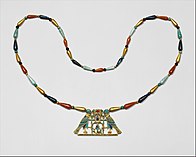




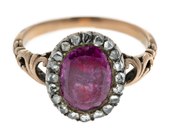








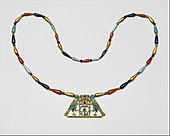



![The Bee Pendant, an iconic Minoan jewel; 1700–1600 BC; gold; width: 4.6 centimetres (1.8 in); from Chrysolakkos (gold pit) complex at Malia; Archaeological Museum of Heraklion (Heraklion, Greece)[39][40]](https://upload.wikimedia.org/wikipedia/commons/thumb/a/a9/Bee_pendant%2C_gold_ornament%2C_Chrysolakos_necropolis_near_Malia%2C_1800-1700_BC%2C_AMH%2C_144879.jpg/170px-Bee_pendant%2C_gold_ornament%2C_Chrysolakos_necropolis_near_Malia%2C_1800-1700_BC%2C_AMH%2C_144879.jpg)




